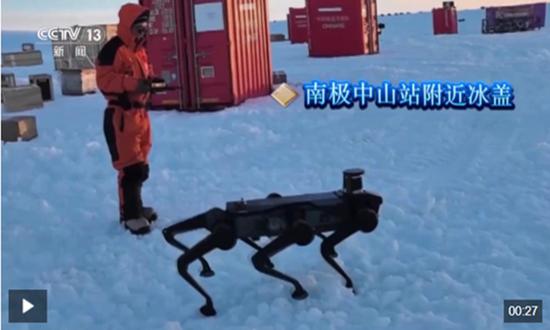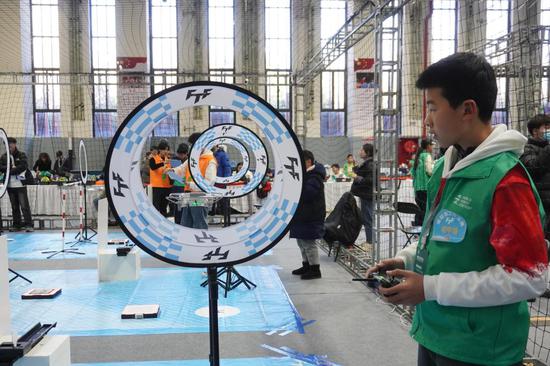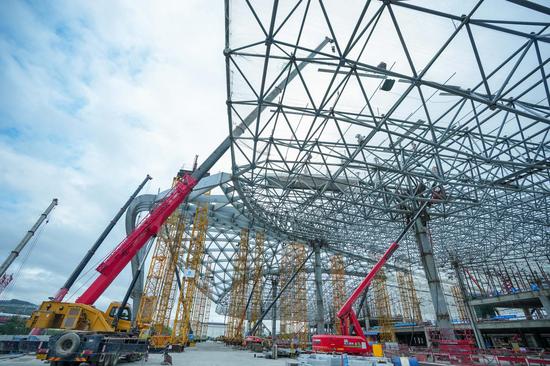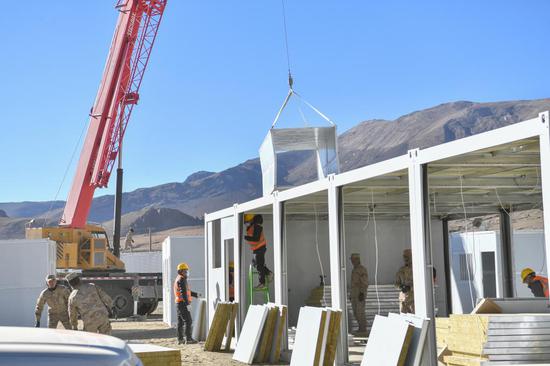
In the ice cap region near China's Zhongshan Station in Antarctica, a domestically developed six-legged robotic dog completes a series of scientific research tests. (Photo/screenshot of CCTV)
In the ice cap region near China's Zhongshan Station in Antarctica, a domestically developed six-legged robotic dog recently completed a series of scientific research tests successfully, marking an innovative step in China's polar research equipment. A video shows the robotic dog navigating through snow and ice, carrying a box on its back, without slipping or falling, according to CCTV.
The developers designed a special type of shoe for the robotic dog to maintain stability to adapt to the harsh environment of Antarctica.
"The material of the shoe itself can withstand temperatures as low as -40 C. Additionally, when it comes into contact with the ice, the pressure it exerts becomes very small, providing anti-slip capabilities while causing minimal damage to the ice surface. This ensures the robotic dog can walk on ice as if it were flat ground," said Mao Shijie, the head of the Antarctic six-legged robotic team and director of Shanghai Branch of the Lenovo Research Institute, CCTV reported.
The robotic dog is equipped not only with specially designed shoes but also with a thermally insulated battery in its abdomen, enabling it to function for two hours in the harsh Antarctic temperatures ranging from -30 C to -40 C.
Nevertheless, this measure alone falls short of expectations, prompting the development team to explore and implement more advanced solutions to significantly extend its battery life.
"For scientific research, we often need it to work for more than four hours, such as during ice surface detection. In such cases, we add two additional batteries on top of the robotic dog, ensuring it can operate for 4-6 hours," Mao added.
According to the CCTV, the six-legged robotic dog now has successfully completed tests involving walking and carrying loads on the slippery, low-temperature ice surfaces of Antarctica, capable of bearing loads between 70 to 100 kilograms. The research team stated that the robotic dog's tasks are not limited to transporting supplies. In the future, it will be improved and upgraded based on the needs of the scientific research teams to support applications such as safety detection and fieldwork operations.
Mao emphasized that the safety is another major concern, as crevices in the ice are invisible when walking on the surface. One of the robotic dog's critical missions is to carry an ice crevice detector and walk ahead of the entire team.
The data collected during the on-site tests will support future upgrades and modifications of the robotic dog. The research team plans to enhance the current technology to enable the robotic dog to take on safety detection tasks.
Additionally, developers aim to integrate the robotic dog with underwater robots and drones to perform combined operations, particularly addressing complex scenarios such as sampling at multiple underwater locations, which are frequently required by research teams.
Beyond scientific research, the six-legged robotic dog is expected to play a role in various other fields, such as monitoring power equipment or providing companionship for elderly individuals living alone or with mobility challenges through the integration of AI technology.
Nowadays, the six-legged robotic dog has been widely applied in the field of power inspection due to its high load capacity and stable walking capabilities. It is capable of monitoring the condition of power equipment and detecting issues such as rust, oil leaks, or instrument abnormalities.


















































 京公网安备 11010202009201号
京公网安备 11010202009201号